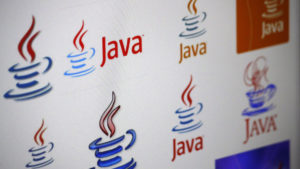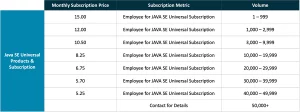- February 15, 2023
- Erwann Couesbot
- Reading Time: 3 minutes

At the start of 2023, Oracle announced that it is once again changing its licensing model for Oracle Java. The original processor-based model is no longer in use, and Oracle is now charging customers based on the number of employees at customers’ organizations under its Java SE Universal Subscription Model.
This licensing change can significantly impact companies of all sizes because the cost of using Java is now directly tied to the organization’s size. For smaller companies, this could mean a decrease in their Java costs. But for larger companies, this could mean a significant increase in costs.
Here, I will give a brief overview of the original Oracle licensing model, discuss how it has evolved since 2018, and map out what we know so far about the impact of this new licensing model.
Oracle’s Previous Java Licensing Models
In 2018, Oracle released its initial subscription-based Java SE (Standard Edition) model, forcing their current customers to buy a license under this new model come 2019. The original Oracle Java SE products were replaced by two subscription-based models: Java SE subscription and Java SE Desktop Subscription.
Along with changing the licensing model, this new Java subscription included new pricing and new public updates. Oracle didn’t require current Java users to switch to the new model, but to encourage current customers to move to the subscription, including ending public updates to older Java models.
As for Oracle’s pricing, the Java SE Subscription used a processor-based metric (CPU) to determine costs while the desktop deployment used a Named User Plus-based metric (NUP) to calculate pricing. You can read more about this previous pricing model in our overview of Java SE Licensing.
How Does the New Java Model Work and How is the Java SE Universal Subscription Priced?
The biggest difference between the old Oracle Java subscription model and the new model is this employee-based metric. This metric, called the Employee for Java SE Universal Subscription, is looking specifically at the number of employees at your organization, not just the employees using Java programs.
When purchasing licenses, the minimum quantity purchased must be equal to your number of employees as of the effective date of your order, with a maximum of 50,000 processors. Employees include:
- Full and part-time workers
- Temporary employees
- Contractors, outsourcers, agents, and consultants that support your internal business operations
Pricing starts at $15 per employee per month, with that price decreasing as your company size grows. The cost is $5.25 per employee per month for organizations with 40,000+ employees.
The standard term length for Oracle agreements is one year; however, Oracle has proposed a 2–3-year term for Java specifically. A longer-term length is in the best interest of Oracle customers as it would allow your organization to price protect Java for a longer time, which could save you more in the long-term.
What Does the New Java Licensing Model Mean for Oracle Customers?
If you are still using Java within the limitation of the free licensing agreement, there is no need for you to purchase a commercial license. However, if you are a net-new customer looking to purchase a commercial license, Oracle will only allow you to subscribe to Java under the new employee-based model.
If you are an existing Java customer, whether on the old subscription model or the original Java SE products, there is no need to switch over to the new Java model – you will be able to renew under your current licensing terms and conditions. Come time to renew, you will have the option to switch to the new model, making it critical to do your homework on which model will be more cost effective for your organization.
There is a good chance that as Oracle continues to roll out this new model, they will put pressure on existing customers to make the switch over. Additionally, for companies that have focused on minimizing their Java usage based on the old model’s metrics, they now must start over with their Java-use strategy if cutting costs is a priority.
For organizations using third party apps on Java, make sure those apps come with licenses. This is similar to the old model, but it is key to making sure you have enough licenses to support the use of that third-party app on Java.
Understanding your licensing options is key to negotiating a best-in-class deal with Oracle. At UpperEdge, we help clients realize the value of their Oracle licensing agreements and supplier relationship every day. If you’re ready to think more strategically about your Java licensing, reach out to our expert advisors today.
Related Blogs
3 Common Mistakes When Counting Your Oracle Named User Plus License Requirements
NEW: Obtain Oracle SaaS Pricing with Free Estimate Calculator
Oracle Fusion ERP: 4 Key Terms to Negotiate
About the Author

